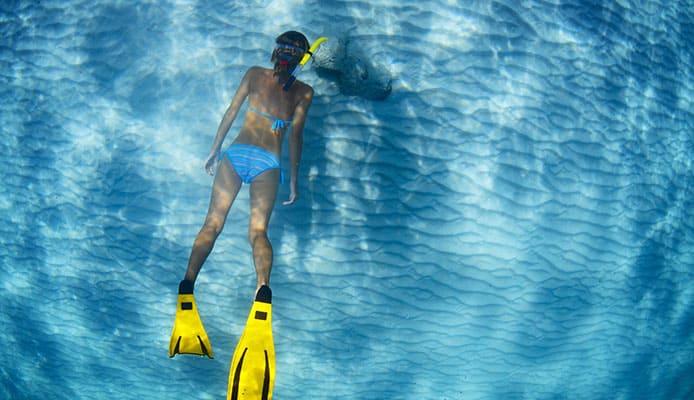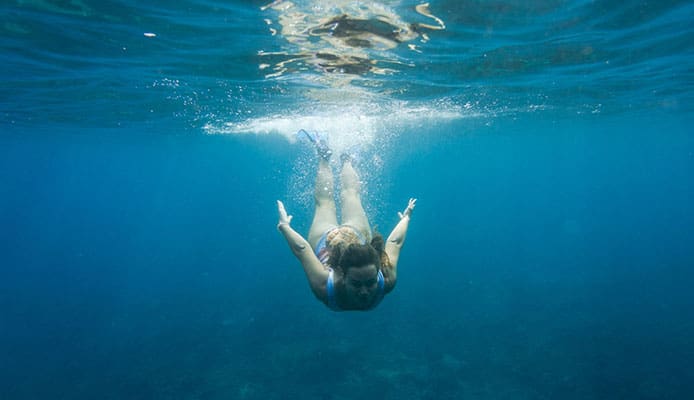
Skin diving sounds simple in theory – you take a deep breath, dive down, see what you want to see and, when done or when you feel you’re running out of oxygen, you dive back up. But in reality, skin diving is a bit more challenging and requires specific techniques.
These techniques will help you get the most out of every dive and make your experience more valuable by teaching you how to breathe properly, how to move, save energy, and last longer under the surface.
Difference Between Skin Diving, Free Diving, and Snorkeling
Skin diving is a part of diving sports and it is similar to snorkeling and free diving. To be more precise, it is a combination of the two. In freediving, the goal is to spend as much time as possible under the surface. In snorkeling, you watch the sea life from the surface, without diving.
When skin diving, you spend most of your time on the surface, observing the world beneath you, and when you see something interesting, you dive down to inspect it. Then, when done, you dive back up and continue to search for other fun things to see or visit. When you compare skin diving to scuba diving, the diver has less equipment and can move easier as it doesn’t require much gear. But the lack of gear means you’ll have to practice some techniques before you dive to stay safe.
Proper Breathing Is Essential
Do not hyperventilate before you get into the water! It will affect your natural breathing rhythm and also flush CO2 from your body. If the CO2 level is too low, you could feel dizzy or like you’re losing air while you’re holding your breath.
Instead of hyperventilating, try to breathe as deep as you can before you dive down. Take a deep breath three times in a row. Then, when you start to take the forth fill your lungs all the way and dive down. If you don’t know how to properly breathe, you could talk to someone who does yoga, or a professional swimmer, to show you a few different breathing techniques. There are lots of breathing exercises that could help you improve not only your dive skills but your general quality of life, especially when you’re anxious.
Trust Your Weight
Ok, you’ve learned how to breathe, it is time for your dive. The key is to save energy by letting the laws of physics to their work. When you dive into the water, do not swim down, let your weight push you. Start by lying still on the surface and bending 90 degrees in your hips, which will make your torso perpendicular to the sea bottom, raise your legs until they’re pointing straight up, and relax.
The weight of your body should take you down. Once your whole body is submerged and you feel that descent has slowed down or stopped completely, start finning.
Don’t Rush And Save Your Energy
Remember, your stamina is limited and by losing the energy, you burn oxygen and will spend less time in the water. So, once you get under the water, don’t rush and move slowly. Stay relaxed and keep your body streamlined. Remember to avoid any sudden moves or unnecessary loss of energy.
This way you’ll stay underwater longer. If you don’t have fins, the best way to move is by breaststroke. When doing the breaststroke, keep your arms close to your body to prevent them from slowing you down. On the other hand, if you have fins, it is good to know how to properly use them.
Fin Technique
There is one basic rule when it comes to fins usage in freediving – do it from the hip with a straight leg, with a mid-sized amplitude and a steady relaxed speed.
Keeping your legs straight will allow the fin to flex at an angle and spill the water off. If you bend your knee, you’ll end up doing “bicycle kicks” instead of moving the way you want to go. If the amplitude of your kick is too fast, your fin blade will ripple along the length and provide you a small amount of movement with lots of energy used. Instead, if your kicks are mid-sized, you’ll do it smoothly, letting your fin blades to bend and push water backward.
Listen To Your Body
At first, you’ll probably be able to stay up to one minute underwater. As you train and progress and with the proper technique, you’ll manage to extend it. But no matter level you’re on always listen to your body. If it says it is time to go back up, listen to it.
The first sign that you’ll have to get back to the surface are convulsions in your diaphragm. When they strike, it means you’ve run out of oxygen and it is time to finish your dive and to catch some air. But it is also important to stay calm and not to panic if they catch you “off guard” and surprise you. Relax and calmly head back up.
Because skin diving happens under the water surface, you’ll have to learn how to equalize your ear pressure to prevent any kind of damage. You’ll do that by pinching your nose and blowing gently. If you don’t feel alright or something feels odd, dive up. If you force it, you could damage your ears.
Proper Underwater Manners
Before you dive, take a walk and ask the locals about the area if you’re new or on a holiday. Watch the currents and tides, but also respect the sea and its inhabitants. Remember, once you dive, you became the visitor, so watch and enjoy as much as you can, but do your best to avoid any physical contact with the creatures down there. You’re on their territory and seeing someone unfamiliar could stress them out which could end up badly if they try to defend themselves.
That’s why it is good to have someone with you while diving. If you have company, don’t dive at the same time. If you’re in a group, dive in pairs, but be sure that there is always someone on the surface watching from above, ready to help if some problem occurs. Especially if you dive around some shipwreck or something even more impressive.
Protect Yourself
While in the water you won’t feel it, but the sun’s rays are stronger when you’re in the water than when on the beach because of the water surface reflection. Always have the sunscreen on. and If you don’t have a wetsuit, use a t-shirt or rash vest to protect your skin.
You might also like: Snorkeling With Glasses
What To Wear And Gear Tips
Ok, you’ve got your mask and swimming fins, which is enough to start with. Now you probably wonder what to wear and what else could you get that will make your diving experience better and produce more amazing memories?
As stated above, if you don’t have one, think about getting a wetsuit. It will not only keep your skin protected from the sun but also will keep you warm while you’re in the water and provide you with extra buoyancy.
If you want to capture those underwater moments and brag to your friends, having a waterproof camera is always a good choice. It is also a good idea to get the diving computer to track your depth, dive time, and water temperature.
Globo Surf Overview
Skin diving is one of the most popular, affordable, and fun things to do on holiday, especially if you’re camping on a beach with your friends or family. But it also requires a good portion of responsibility, as you’ll have to use the above-described techniques to stay safe. If done properly, you’ll have amazing memories to talk about or show to your friends. They should be enough to get you started, the rest is up to you and your will to explore and learn new things.
More Snorkel Guides:
Snorkeling With A Mustache Or A Beard
How To Snorkel: A Complete Beginners Guide


